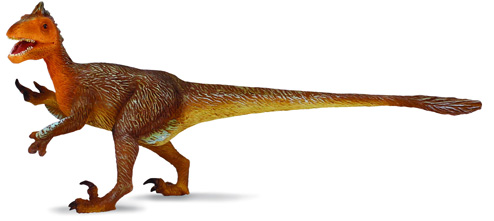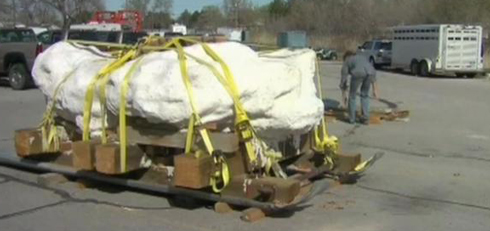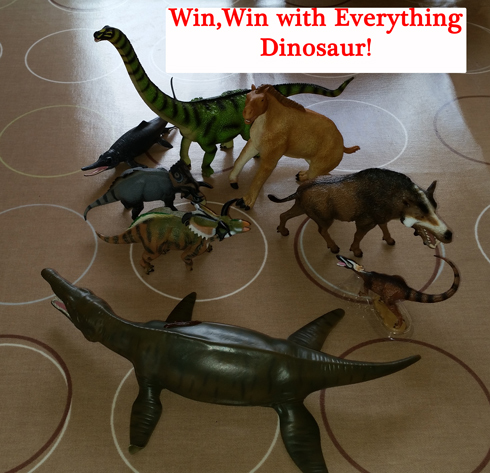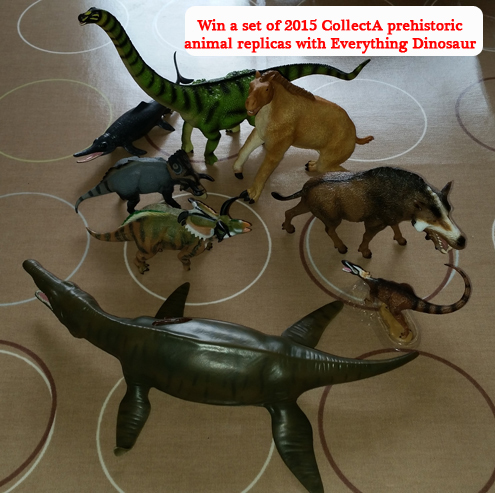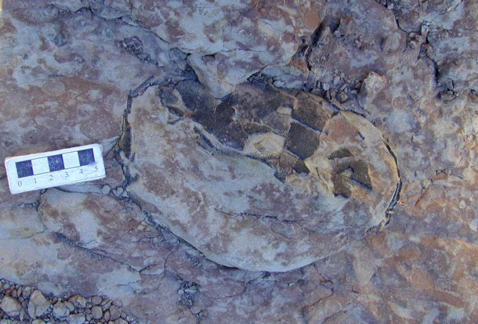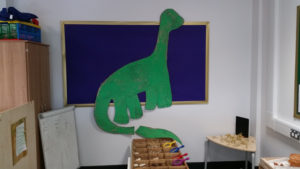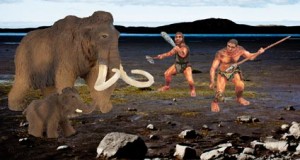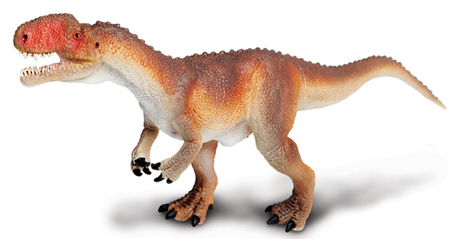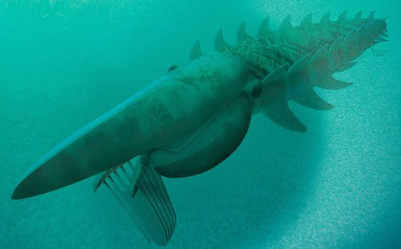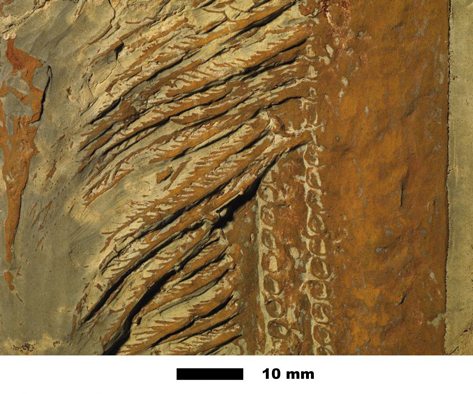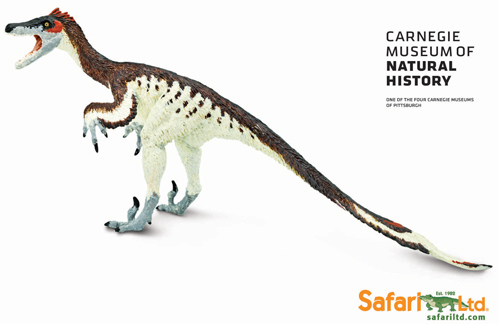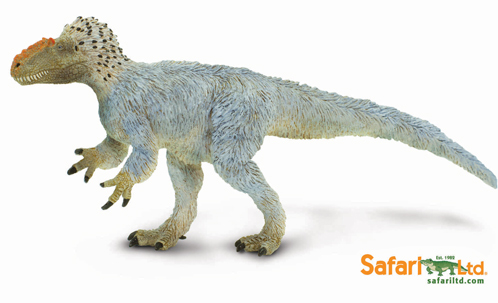Carnufex carolinensis – Three Metre Long Crocodylomorph Challenged Early Theropod Dinosaurs
Palaeontologists from North Carolina State University and the North Carolina Museum of Natural Sciences have published a paper in the open access journal “Scientific Reports” about their research into one of the most fearsome predators that roamed the Americas during the early stages of the Late Triassic some 231 million years ago. The reptile, identified as an ancestral crocodile has been named Carnufex carolinensis and it probably occupied an apex predator position in the lush, humid, tropical ecosystem as represented by the strata of the Pekin Formation found in North Carolina.
An Illustration of the Fearsome Crocodylomorph C. carolinensis
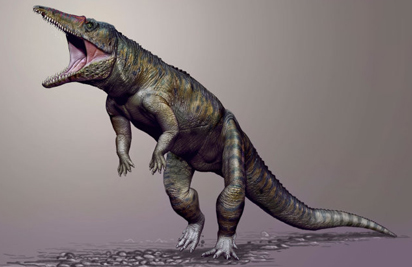
Fearsome predator of the Triassic.
Picture credit: Jorge Gonzales
The fossilised remains were found in Chatham County. They include a fifty-centimetre-long partial skull, which when digitally mapped and reconstructed in three dimensions provided the scientists with a very accurate picture of the skull of this carnivore. It may have walked on four legs for some of the time, but it would also have been able to rear up onto its powerful hind legs, perhaps to help it run down prey. C. carolinensis was very probably a facultative biped.
Commenting on the significance of the study, Assistant Research Professor at North Caroline State University, Lindsay Zanno said:
“Fossils from this time period are extremely important to scientists because they record the earliest appearance of crocodylomorphs and theropod dinosaurs, two groups that first evolved in the Triassic Period, yet managed to survive to the present day in the form of crocodiles and birds. The discovery of Carnufex, one of the world’s earliest and largest crocodylomorphs, adds new information to the push and pull of terrestrial top predators across Pangea.”
Rapid Evolution
After the end Permian extinction that wiped out a lot of terrestrial animals there seems to have been a period of rapid evolution as new animal types evolved to exploit the vacant positions in ecosystems. The fossil record from the Early and Middle Triassic indicates that land-living predator diversity attained new levels with a seeming overabundance of carnivorous animals due to the evolution of entirely new types of predator. One of the most significant clades to evolve was the Crocodylomorpha that still survive today. The crocodiles represent one of only two archosaurian lineages that are extant.
The second lineage are the Aves (birds). In contrast to their modern-day descendants, the earliest crocodylomorphs were generally small, cursorial animals occupying a subsidiary role to other types of predator. However, C. carolinensis represents a large-bodied taxon with a slender skull, lined with sharp teeth. It was clearly a formidable hunter and these fossils from Chatham County represent the remains of one of the oldest and earliest diverging crocodylomorphs described so far.
Roaming Pangea at the time were large terrestrial predators which formed the rauisuchians group, amongst the rauisuchids there was a sub-group of poposauroids which were also mainly predatory. In the southern part of the super-continent, these types of ancient crocodile-like creatures competed with the rapidly evolving theropod dinosaurs. The fossils of Carnufex also suggest that in the northern part of Pangea, large-bodied crocodylomorphs, not dinosaurs were making up a large portion of the apex terrestrial predators.
Lindsay Zanno went onto add:
“These animals hunted alongside the earliest theropod dinosaurs, creating a predator pile-up. We knew that there were too many top performers on the proverbial stage in the Late Triassic. Yet, until we deciphered the story behind Carnufex, it wasn’t clear that early crocodile ancestors were among those vying for top predator roles prior to the reign of the dinosaurs in North America.”
Although the skull material was fragmentary, the scientists were able to build up a picture of the features of Carnufex using comparisons with better known crocodylomorphs from the fossil record. Sophisticated computer modelling helped the scientists to piece together the skull of this ancient crocodile.
A 231-Million-Year-Old Jigsaw Puzzle
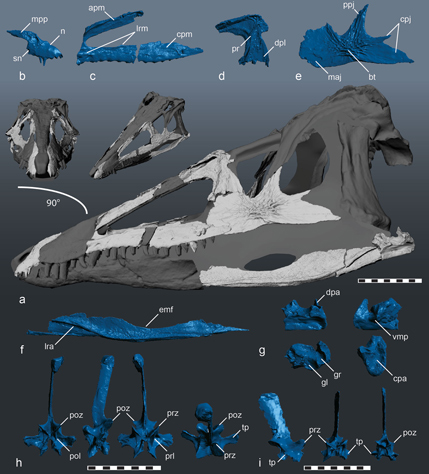
Piecing together the skull from the fragmentary bones.
Picture credit: North Caroline State University
The picture above shows the various bones associated with the fossil specimen (blue), these have been superimposed on a model of a skull (white parts relate to fossil material, grey pieces are based on related animals from the fossil record).
As the Triassic period came to an end there was another set of extinctions, although nowhere near as dramatic as the End Permian extinction. Many of these large, apex predators did not survive into the Jurassic, only the small-bodied crocodylomorphs and the Theropoda survived.
Lindsay Zanno stated:
“Theropods were ready understudies for vacant top predator niches when large-bodied crocs and their relatives bowed out. Predatory dinosaurs went on to fill these roles exclusively for the next 135 million years or so.”
However, for the ancestors of today’s crocodiles, gharials, caimans and alligators there were plenty of other ecological niches for them to exploit. As the theropods began to get bigger and bigger, these early crocodiles continued to flourish but this time they occupied secondary predatory roles.
Graduate student Susan Drymala of North Carolina State University and a co-author of the study put it rather nicely when she explained:
“The ancestors of modern crocs initially took on a role similar to foxes and jackals, with small, sleek bodies and long limbs. If you want to picture these animals, just think of a modern fox, but with alligator skin instead of fur.”
Perhaps the most famous member of the Order Rauisuchia is Postosuchus, fossils of this six-metre-long giant have been found in North Carolina. However, it appeared around ten million years after Carnufex carolinensis roamed the Earth. The last of the large-bodied rauisuchians became extinct at the end of the Triassic.
A Famous Early Crocodile – Postosuchus
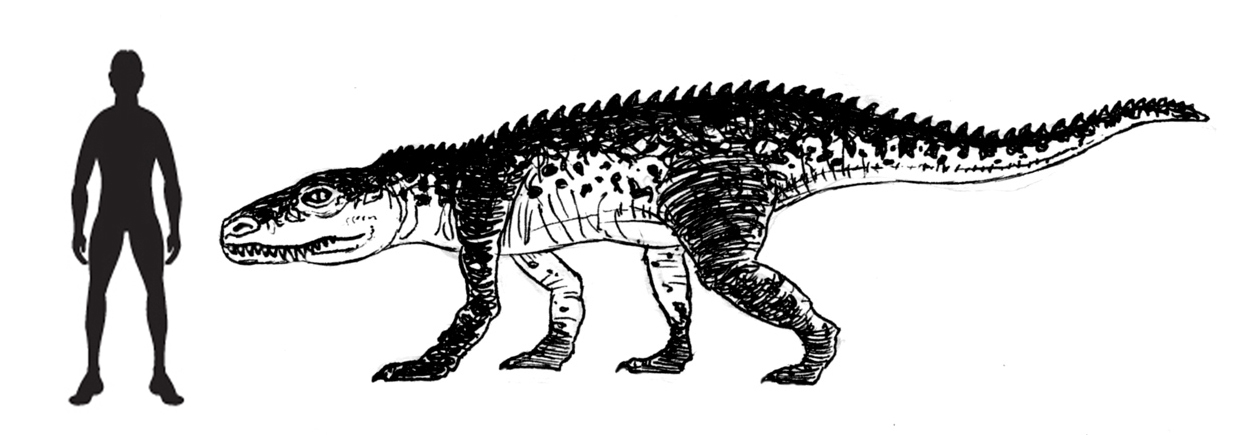
Scale drawing of Postosuchus.
Picture credit: Everything Dinosaur
Everything Dinosaur stocks a range of crocodylomorph replicas and models. To view some of these figures: Safari Ltd. Prehistoric World Models.


